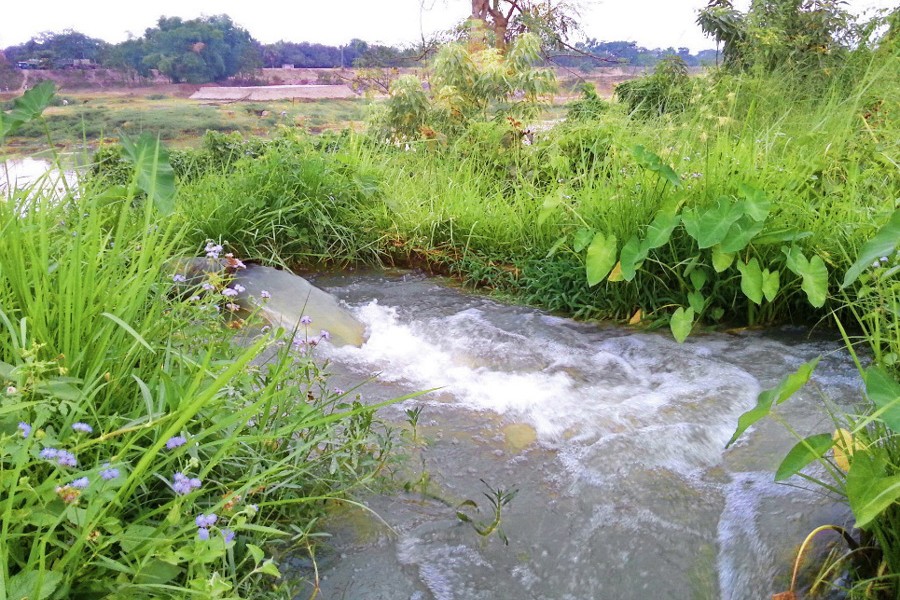Soil pollution as outcome of environmental crimes

Polin Kumar Saha and Jannatul Ferdaous Sathi
Published :
Updated :

Soil is the basic element for ultimate nutrient sources of all the living organisms in the ecological system. Soil keeps our environment well balanced or harmony of living and non-living organism and their interaction in a particular space. It is the most valuable and vital resource for sustenance of life and also for any developmental activity. But gradually, the human greediness towards harvesting nature has been observed as an illegal or unauthorized act, which could be documented as an environmental crime leading to soil pollution. With so many human disturbances in nature, soil pollution is an environmental crime in this industrial era.
It is an alarming piece of news for us that one third of global soil is already degraded. How severely the industrial hazardous waste disposal is influencing the soil-based pollution that is a vital question for us. As we know, during the industrial manufacturing processes a large volume of solid waste and excluded chemical (like plastic materials, chemical product, sludge etc.) are dumped on the surface. Per capita solid waste in Bangladesh is small but the total amount of growing solid waste is quite significant. Secondary sources indicate that the number of manufacturing establishments in Bangladesh is approaching 30,000 factories, including all of these facilities that use more than 40 different types of chemicals. Estimates for solid waste generated in Dhaka city vary from 3,000 to 3,500 tonnes per day. They come from mainly households, commercial and industrial establishments and street sweepings. Households generate most of the solid waste, accounting for nearly 45% of the total. It has recently been designated from different assessment that waterlogging of our major cities is found alarming due to mainly unsustainable management of solid waste, which ultimately affects our soil body.
In another major environmental crime-based soil pollution, farmers use large amounts of inorganic fertilizer and chemical pesticide to produce food (not quality!), which process of agricultural practices reduces soil fertility and damages soil composition. Brick kilns have become the fastest growing industries in the last few years of our country. Most of the main ingredients of brickfield is fertile topsoil of agricultural land. An estimate shows three-kilogram soil is used for one brick. This is why large amounts of agricultural land are decreasing day by day that may lead to food insecurity and vulnerable livelihood in the coming decades, apart from arable land degradation and environmental deterioration in the country.
However, it's time to achieve SDGs (sustainable development goals) where we must adopt various policies on our development paths so that all of our development processes could really be framed towards sustainability principles. For example, the National Agriculture Policy (1999) must be implemented in integrated ways to ensure sustainable agricultural production, conservation of crop biodiversity, introduction of new technology, increased use of organic manure, integrated pest management system, efficient irrigation system, diversification of crop and establishment of agro-processing and agro-based industries. As the outcome of good agriculture policy implementation in China, their major goals are to increase the proportion of contaminated farmland that can be used safely as expected to be 90 per cent by 2020.
The government of Bangladesh has modified several environmental acts, rules and laws to lessen the environmental crimes. Environment court has already been established to take prompt legal action against soil pollution. On top of that, soil damage can be mitigated by the promotion of renewable resources such as solar power and biomass. The expansion of renewable sources in the country is not still at the accepted level of global demand. According to these goals, 20 per cent of Germany's electricity and 10 per cent of Germany's primary energy demands should be covered with renewables by 2020. According to a study of the German Ökoinstitut, about 10% of the German electricity, heating, and fuel for cars could be produced from biomass alone by 2020.
Towards destination, we need also more cooperation in more public private partnership, and we definitely see some positive initiatives as well. For example, Waste Concern, a local NGO, and Department of Environment have already demonstrated the success of involving community in waste recycling. This community approach has been performed successfully on waste collection. But a problem arises with the insufficient capacity of the city corporation to collect this accumulated waste from community collection centers for dumping in the landfills. The institutional arrangements are envisaged including a high-level committee on hazardous waste (HW) formed to coordinate the implementation of the policy and to provide technical guidance for a Hazardous Waste Management Cell (HWMC) to be established in the Department of Environment, as a focal point for HWM and promotion of cleaner production practices.
Finally, people of Bangladesh saw around 234,000 deaths, including 80,000 in urban areas, due to environmental pollution and related health risks in 2015, making it one of the worst affected countries in the world. Bangladesh is the most vulnerable country on this issue as revealed in the World Bank report. Overcoming environmental crimes against soil can be a corollary goal in implementing the proper waste management policies. In any ways, any type of anthropogenic activities need to be sorted out from different sources.
Polin Kumar Saha and Jannatul Ferdaous Sathi are environmental professionals at Iso Tech Group.
polin.msls2009@gmail.com; jannat.sathi007@gmail.com


 For all latest news, follow The Financial Express Google News channel.
For all latest news, follow The Financial Express Google News channel.